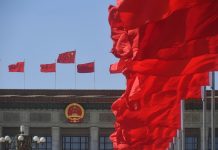
Leaky roofs on rainy days, crumbling exterior walls, poor insulation and soundproofing, as well as aging plumbing and wiring… These problems not only diminish the comfort of homes but also create potential safety hazards.
“Homes, much like people, age over time and can also develop problems as they grow older,” said Wang Shengjun, a spokesperson of the Ministry of Housing and Urban-Rural Development (MOHURD), said at a press conference on
August 2, adding that this requires setting up a regular inspection system for residential buildings, with the frequency determined by the building’s age and function.
Recent data from the MOHURD show that at the end of 2022, nearly 20 percent of existing urban buildings in China were over 30 years old, meaning they are entering the mid-to-late stages of their designed lifespan. It is projected that by around 2040, nearly 80 percent of the buildings will reach this stage. As the number of aging homes continues to grow, these older buildings are confronting “elderly care” challenges.
Repairing these aging homes will require a huge amount of funding. It is against this backdrop that China has proposed a housing pension scheme.
“China is exploring the establishment of systems for home inspections, “housing pensions” and housing insurance to build a long-term mechanism for managing housing safety throughout a building’s entire lifecycle,” Vice Minister of Housing and Urban-Rural Development Dong Jianguo said at a press conference on August 23. Currently, 22 cities, including Shanghai, are conducting pilot programs, he said.
From old to gold
A housing pension is typically a special fund allocated for the repair, renovation and upgrading of shared parts and facilities in buildings after the designed lifespan has expired.
“China’s urban development has shifted from large-scale expansion to a new phase featuring both upgrading existing buildings and infrastructure and optimizing the development of new housing projects,” an official from the MOHURD, told Xinhua News Agency on August 26. “We’re entering a critical period of urban renewal.”
“Establishing housing pensions is a key measure in the urban renewal process, aimed at addressing pressing public concerns and improving the safety management of existing buildings,” he said. “It not only addresses immediate needs but also provides a long-term solution for housing maintenance and safety.”
According to an editorial published by Architecture Magazine, a publication affiliated with the MOHURD, housing construction costs are calculated to form local per-square-meter averages and homebuyers make a one-off contribution to the housing maintenance fund based on these averages. Included as part of the purchase price, these contributions are between 5 and 8 percent of construction cost and are calculated according to floor space. While these funds play a vital role in ensuring the daily safety and operation of residential communities, their limited sizes are now becoming insufficient to meet the growing needs of maintaining urban housing safety and upgrading aging residential buildings.
“Thus, the housing pension scheme is especially necessary,” Yan Yuejin, Deputy Director of the E-house China R&D Institute in Shanghai, told China City News. “It helps slow down the aging process of residential buildings, and subsequently boosts their value.”
“The system has positive implications for improving residents’ housing conditions, stabilizing the real estate market, and boosting the growth of related industries,” Guan Rongxue, a senior analyst with Zhuge Real Estate Data Research Center, said. She explained that this initiative not only increases the value of aging homes and diversifies the housing market but also strengthens market confidence.
“The scheme is expected to drive the development of related industries such as renovation and building materials, further promoting economic growth,” Guan said.
In July, the State Council released an action plan for deepening new urbanization, which identified the renovation of aging residential communities as a key task. It called for updating infrastructure such as water, electricity, roads, gas, communication, heating, fire safety, security systems, and waste management, as well as repairing public areas within communities, emphasizing the renovation of urban residential areas built before the end of 2000.
As a result, the renovation of aging residential communities will be a major focus in the coming years and could even become a stimulus for China’s economic growth.
Experts believe that the housing pension plan may bring new growth opportunities for property management companies, intermediaries, insurance companies, financial institutions and construction enterprises.
According to an article published by Lifeweek magazine, as housing sales in China continue to decline, especially in the new home market, which has experienced nearly four consecutive years of negative growth, the renovation and repair of old residential buildings has the potential to become a new driver of economic growth. In the past, China’s real estate market was primarily driven by new home sales. However, with the slowdown in that sector, the question of how to unlock the value of existing homes has emerged as a new growth opportunity. The large-scale renovation of aging homes presents an enormous untapped potential.
Where the funds come from
A report from the Shanghai Real Estate Science Research Institute shows that the combined balance of housing maintenance funds nationwide exceeds 1 trillion yuan ($140.6 billion). In some cities,
including Shanghai, Beijing, and Hangzhou in Zhejiang Province, the amount of funds used accounts for only about 10 percent of the total funds collected. In Chengdu, Sichuan Province, and Shenzhen, Guangdong Province, the usage rates are even lower, at around 4 percent and 5 percent, respectively.
Since the funds have not yet been fully used, they can temporarily provide a source of funding for the housing pension. However, as the aging of residential buildings in China continues to increase, the demand for these maintenance funds will also rise significantly.
Then, where will the funds come from?
Dong said the housing pension plan will consist of two types of accounts—personal accounts and public accounts.
Personal accounts are those that have been established through home buyers’ contribution to the housing maintenance fund as part of their initial purchase, so the focus of the pilot “housing pension” scheme is for local governments to establish public accounts, Dong said.
According to the MOHURD, these public accounts are established by local governments based on the principle of “not increasing individual burdens or diminishing personal rights.” In the 22 pilot cities, a certain proportion of land transfer fees, capital gains on housing maintenance funds and fiscal subsidies can become sources of funds for the public accounts. The goal is to create a stable funding channel for housing safety management without requiring additional payments from residents, ensuring that personal financial burdens are not increased.
Following the announcement of the housing pension initiative, some expressed concerns, suggesting that it is a disguised form of property tax. Experts have made it clear that this is a misinterpretation.
“The housing pension and property tax are entirely different concepts,” Zhao Xiuchi, Dean of Beijing-Tianjin-Hebei Real Estate Research Institute at Capital University of Economics and Business, said.
The housing pension is intended for maintaining the safety and longevity of buildings, while the property tax is a tool for regulating the real estate market, influencing transactions, increasing government revenue, and addressing income inequality, she explained. –The Daily Mail-Beijing Review news exchange item





